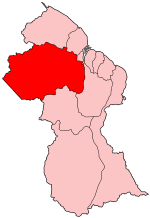Cuyuni-Mazaruni
| Cuyuni-Mazaruni Region 7 | |
|---|---|
| Administrative Region | |
 Map of Guyana showing Cuyuni-Mazaruni region | |
| Country | Guyana |
| Regional Capital | Bartica |
| Area | |
| • Total | 47,213 km2 (18,229 sq mi) |
| Population (2012 census) | |
| • Total | 20,280 |
| • Density | 0.43/km2 (1.1/sq mi) |
| [1] | |
Cuyuni-Mazaruni (Region 7) is a region of Esequiban Guyana, a territory in dispute by Guyana and Venezuela, bordering the regions of Barima-Waini, Essequibo Islands-West Demerara and Pomeroon-Supenaam to the north, the region of Upper Demerara-Berbice to the east, the region of Potaro-Siparuni and Brazil to the south and Venezuela to the west.
Its capital is Bartica, with other major towns including Issano, Isseneru, Kartuni, Peters Mine, Arimu Mine, Kamarang, Keweigek, Imbaimadai, Tumereng and Kamikusa.
It covers an area of 47,213 km². Before the 1980 administrative reform most of the area belonged to the Mazaruni-Potaro district.
Population
The Government of Guyana has administered three official censuses since the 1980 administrative reforms, in 1980, 1991 and 2002.[2] In 2012, the population of Cuyuni-Mazaruni was recorded at 20,280 people.[3] Official census records for the population of the Cuyuni-Mazaruni Region are as follows:
- 2012 : 20,280
- 2002 : 17,597
- 1991 : 14,794
- 1980 : 14,390
Communities
(including name variants):
- Ajimipepai
- Akar (Akar Village)
- Amamure Village (Amamuri Village)
- Amokokopai Village
- Apanachi
- Arau Village
- Arawai Village
- Arimu Mine
- Assura Village
- Aunama (Aunama Village)
- Aurora
- Awarabati
- Barakara
- Bartica (Barteke)
- Butakari (Butukari)
- Ekereku
- Enachu (Enachu Landing, Enachu Station)
- Golden Grove
- Hororabo
- Imbaimadai
- Issano
- Isseneru
- Kaikan
- Kalacoon (Kalakoon House, Kalakun, Kalkoon)
- Kamarang
- Kamaria
- Kamikusa
- Kamuda (Kamuda Village)
- Kartuni
- Kaywaek (Kaywaek Village)
- Keweigek
- Klip
- Kokadai
- Kowaeng (Kowaeng Village)
- Kurachi
- Kurutuku Village
- Kwiokrebaru
- Lower Kamaria
- Meruwang
- Minata
- Mongreppo
- Morowta
- Muriakundi (Muruakundi)
- Muruwawe Village
- Opadai
- Oranapai (Oranapai Landing, Oranopai)
- Paruima (Paruima Mission)
- Pathawaru
- Peters Mine
- Pipillipai
- Poterima
- Saint Edwards Mission
- Saint Marys
- The Clip
- Tumereng (Tumareng, Tumureng)
- Upper Kamaria
- Waioklepalul (Waioklepaluta Village)
- Waramadong (Waramadong Village)
- Wineperu
- Wolga
See also
References
- ↑ Macmillan Publishers (2009). "Administrative Regions - 1 and 7". Macmillan Junior Atlas: Guyana. Oxford: Macmillan Caribbean. p. 36. ISBN 9780333934173.
- ↑ Beaie, Sonkarley Tiatun (19 September 2007). "Chapter 3: National Redistribution and Internal Migration" (PDF). 2002 Population and Housing Census - Guyana National Report. Bureau of Statistics. p. 51. Archived from the original (PDF) on 2 September 2012. Retrieved 29 August 2012.
- ↑ Beaie, Sonkarley Tiatun (19 September 2007). "National Population Trends: Size, Growth and Distribution" (PDF Download). 2002 Population and Housing Census - Guyana National Report. Bureau of Statistics. p. 25. Retrieved 29 August 2012.
Coordinates: 6°27′34″N 60°12′40″W / 6.459522°N 60.211075°W